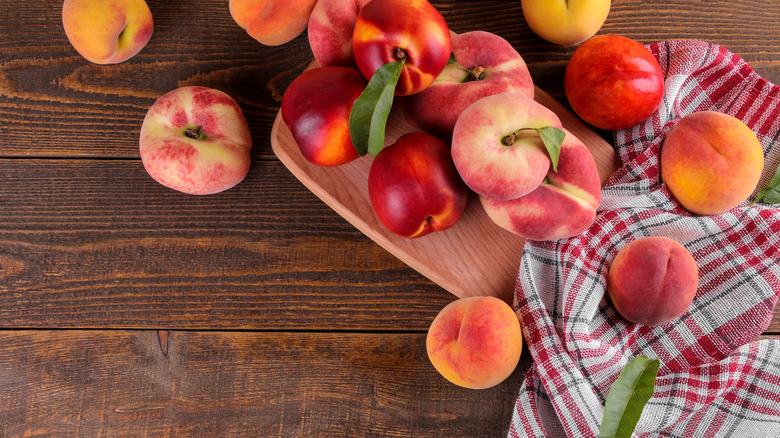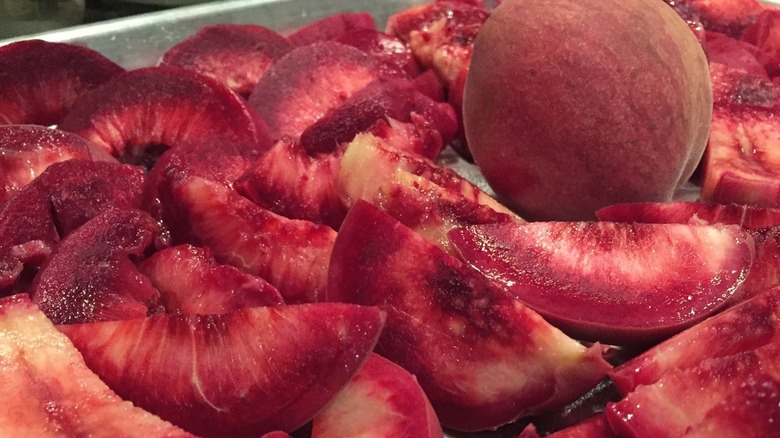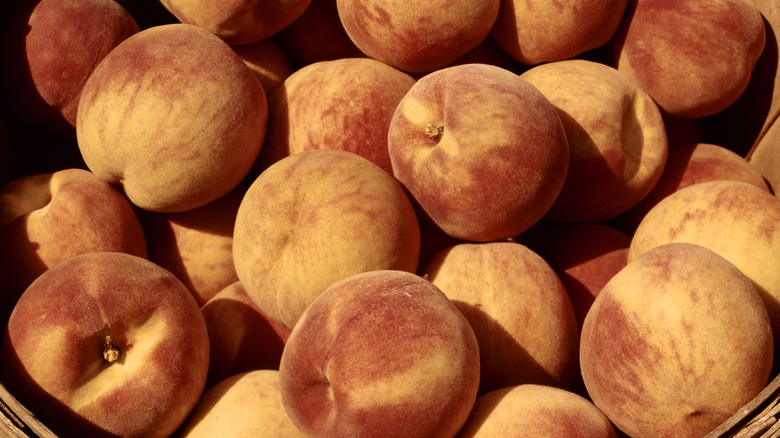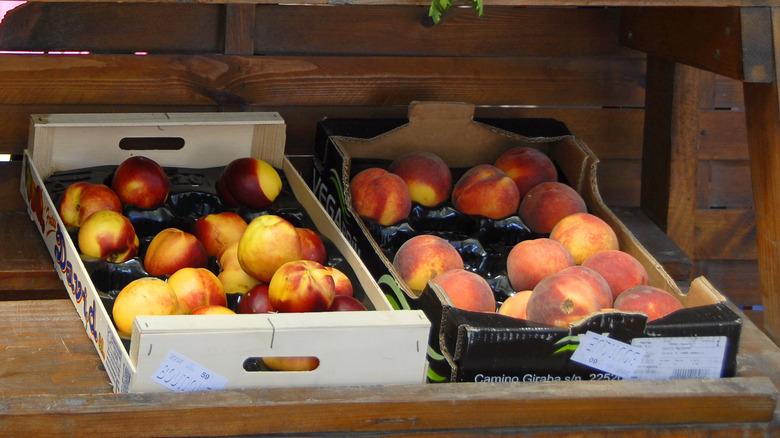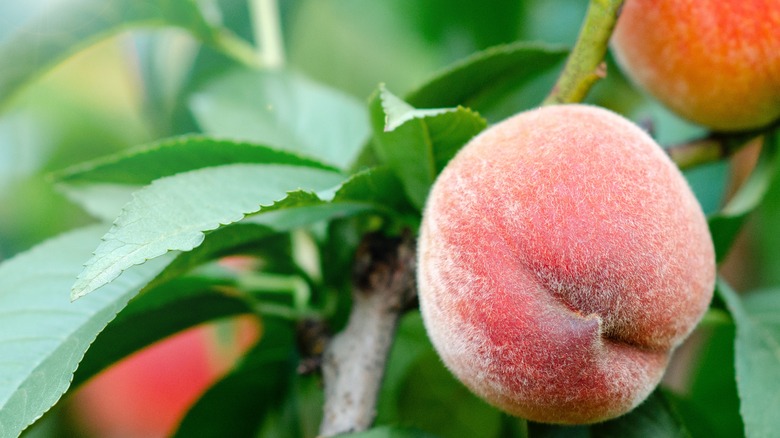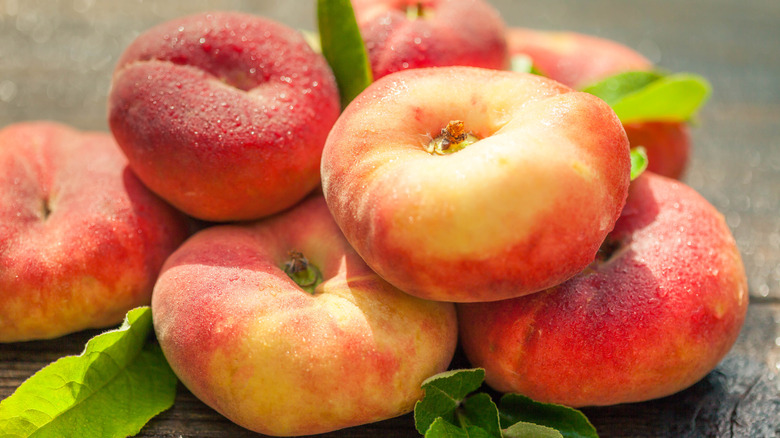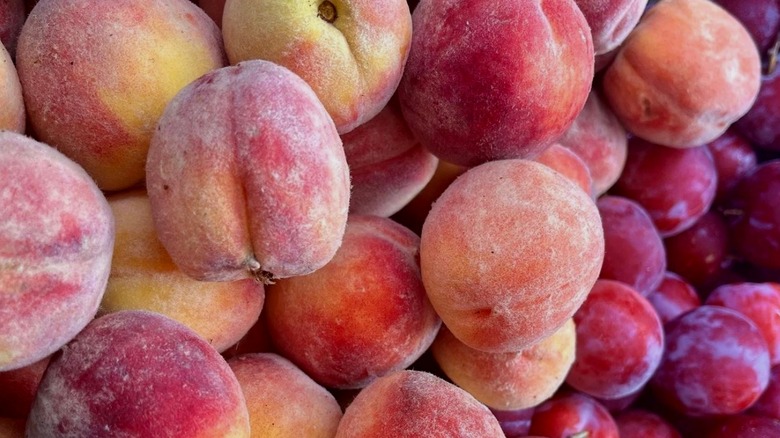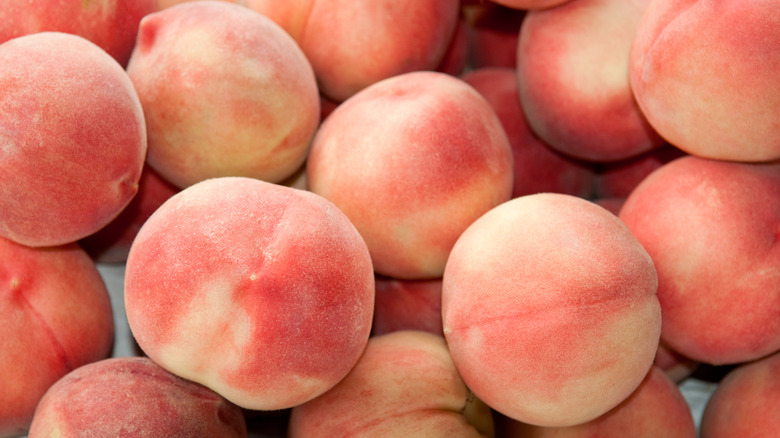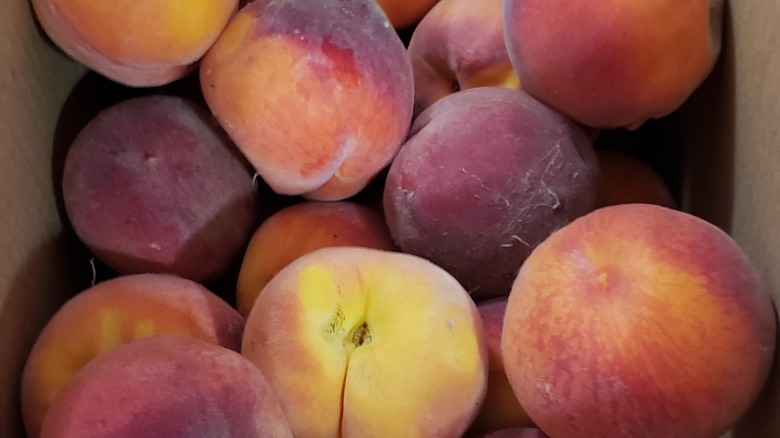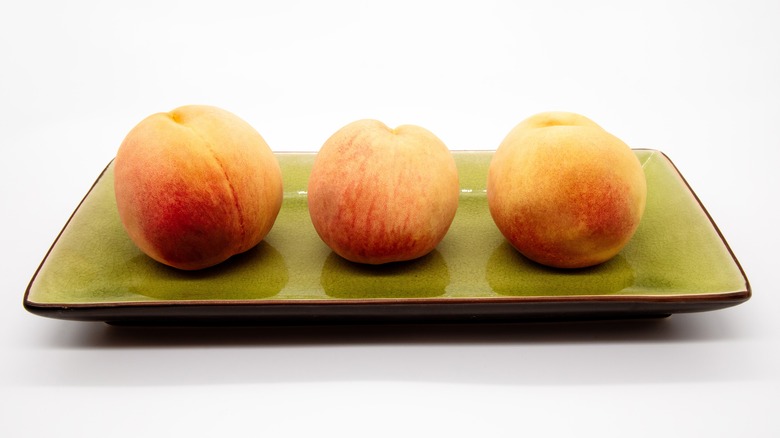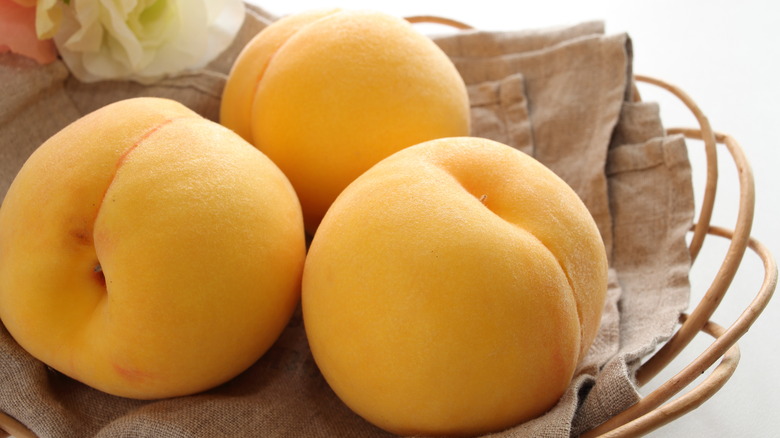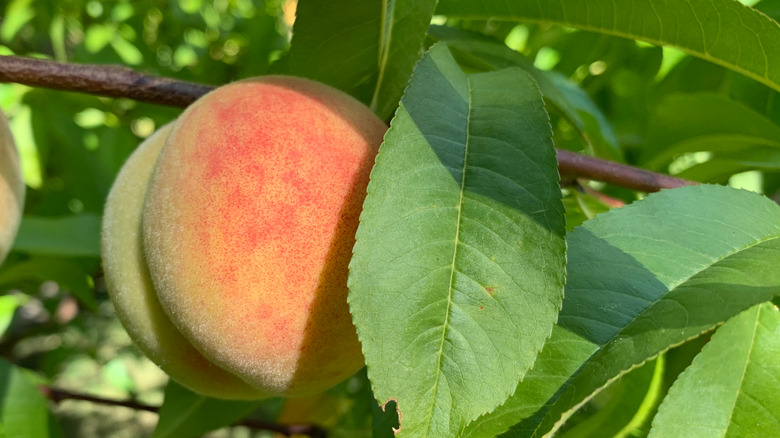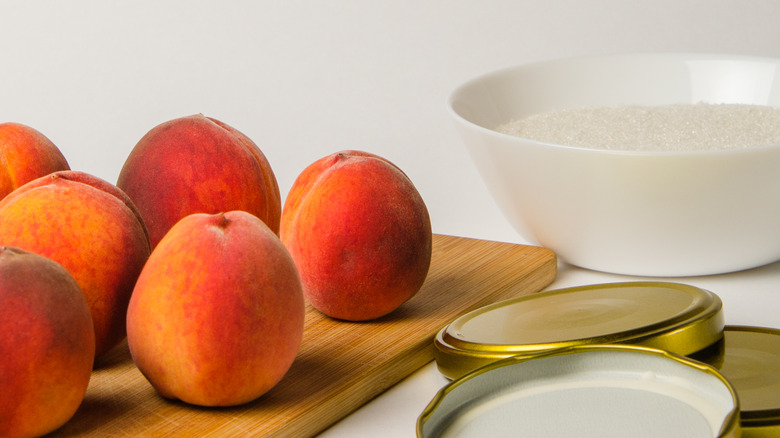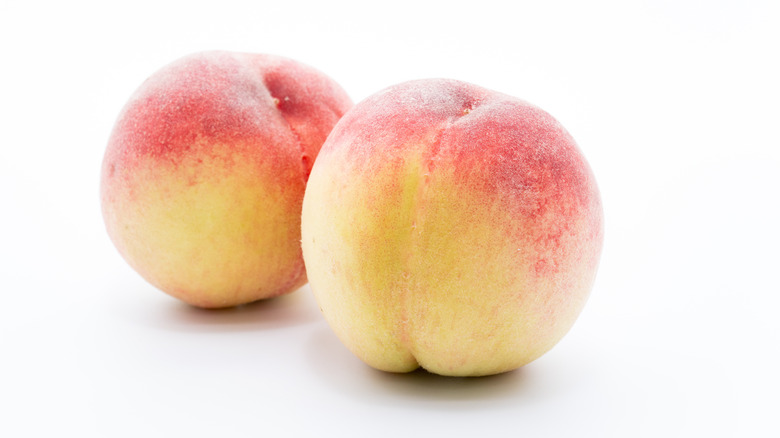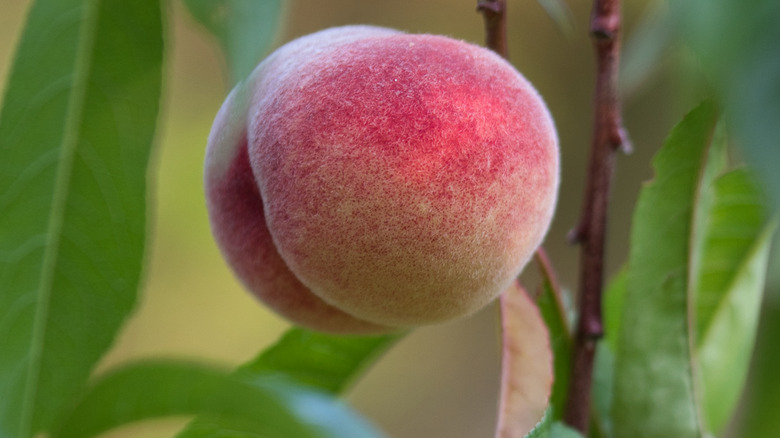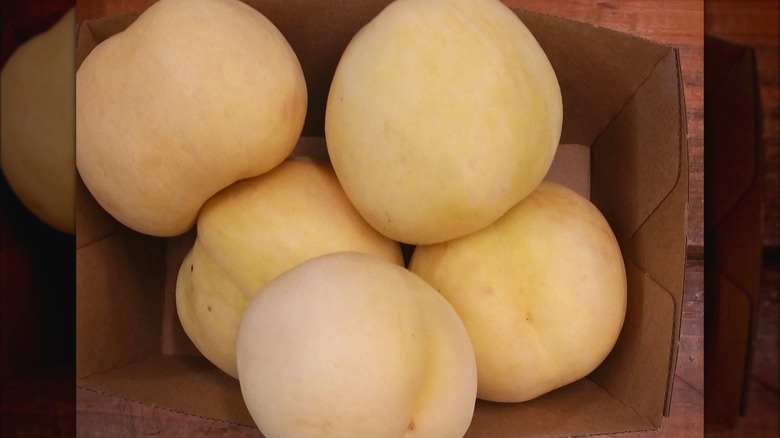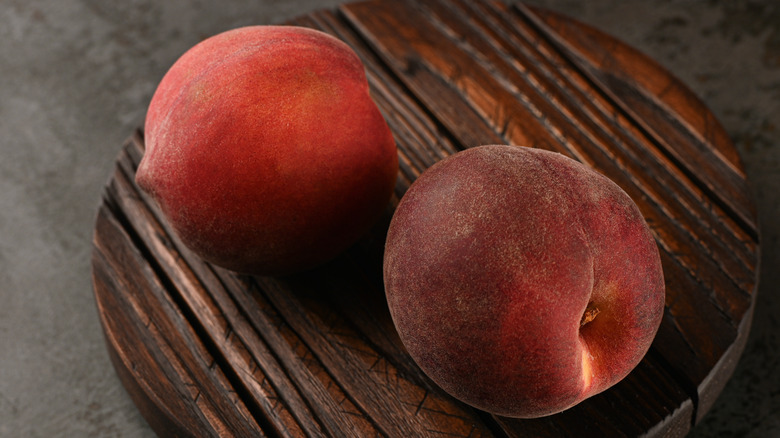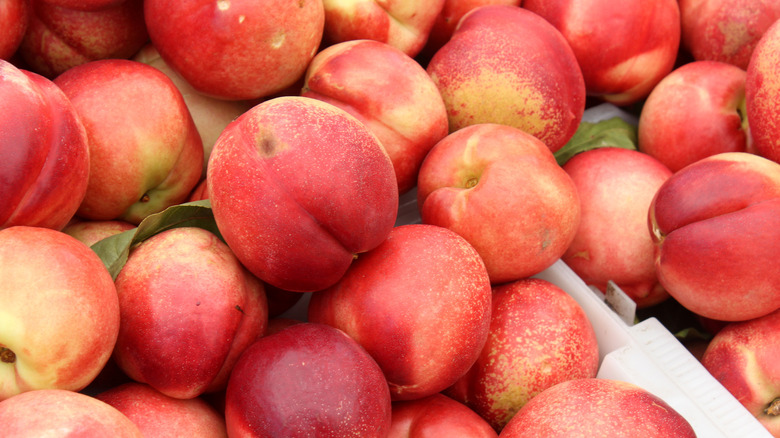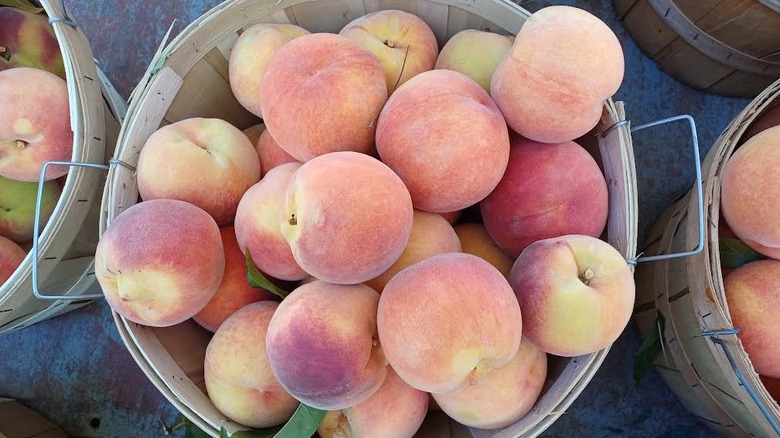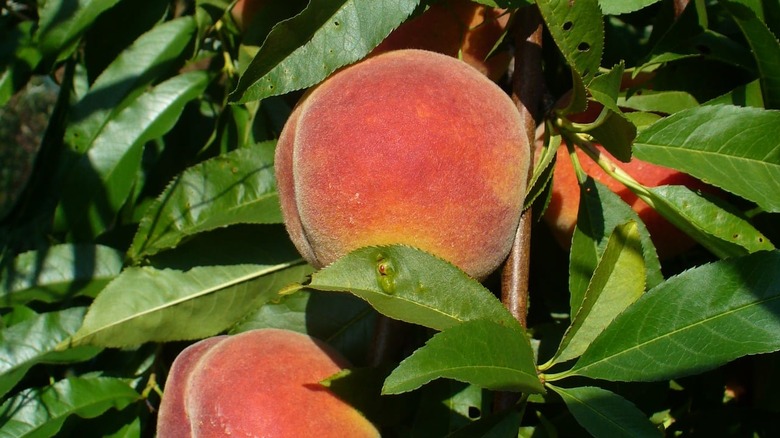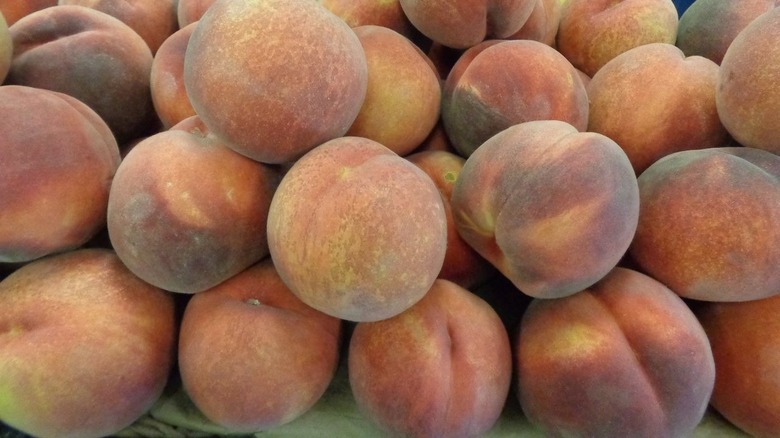20 Types Of Peaches And The Best Ways To Use Them
There's more to peaches than what meets the eye. Although you might think they're all essentially the same, there are hundreds of varieties grown in the United States alone and thousands worldwide. These peach varieties come with many distinctive characteristics. They may be distinguished from each other by their appearance, flavor, history, nutritional content, harvest time, or lineage.
However, each variety can fit into one of three categories: clingstone, freestone, or semi-freestone. Freestone peaches are the easiest to handle since their flesh doesn't adhere to the stone. However, clingstone peaches require more effort to remove their pits. Semi-freestones are in between, with the stone and flesh of these peaches only partly clinging to each other.
Whether you're new to learning about peaches or you're a seasoned connoisseur, these varieties will impress you with their unique qualities. Read on to discover how you can best use these stone fruits in your recipes.
1. Blood peaches
Blood peaches have a deep red-colored flesh on the inside. On the outside, their skin is dark red, but somewhat masked by fuzz. In terms of taste, these fruits boast a unique blend of floral and acidic notes. This slight tartness is more enjoyable than you might think. If you want to try some, these special fruits are not widely commercially grown, but you can purchase them from select farms or markets. If you live in the Southeastern part of the U.S., you might come across a Blood peach tree in nature.
Whichever way you obtain the fruit, it's a wonderful addition to many dishes as a raw garnish. Although you can certainly cook or bake with it, you miss out when you don't use it fresh, as it's best to allow its vibrant color and flavor to take center stage. For instance, add some slices to a parfait, mousse dessert, or even a charcuterie board.
2. Hale Haven
This beautifully golden-yellow peach is of the freestone variety. Its skin is thick, but internally, it has super moist flesh with a saccharine flavor. Hale Haven peaches are typically ready to pick towards the later part of summer, but in some areas, they're ready earlier. You can keep an eye out for them at street markets or orchards if you want to get your hands on some.
This type of peach has many uses. Not only does it successfully sweeten up desserts, but it's also ideal for canning since the pit releases easily. You can even slice up Hale Haven peaches and freeze them to extend their shelf life. That way, they'll be ready to go for your next baking project.
3. Corsica
As the name suggests, Corsica peaches are grown in Corsica, an island in the Mediterranean Sea. Some have white flesh, and others have yellow. Some are categorized as freestone peaches, while others are considered clingstone peaches. The harvest season for them lasts from the end of spring until fall.
These specialty fruits are exported from the island on which they grow, making them available all over Europe. So, if you ever come across them in your European travels, you can savor them by pairing them with meat and cheese, using them as a dessert topping, poaching them, or grilling them. From their delicate flesh to their fruity flavor, they are a joy to eat, raw or cooked.
4. Arctic Supreme
Arctic Supreme is a white-fleshed fruit with plenty to offer. It isn't entirely sweet or sour but has a perfect balance of both flavor profiles. It's a hybrid fruit that a company called Zaiger Genetics developed with this delicious flavor in mind. This fruit is in season from mid-summer to fall, so you can enjoy it during peak summer when you're craving something juicy to beat the heat.
However, the next best way to take advantage of its flavor is to make preserves or jam with your Arctic Supreme peaches. You can use it in a beginner peach jam. The recipe's ingredients of spicy ginger, tart lemon juice, and sweet sugar will complement the tanginess of this peach variety perfectly.
5. Donut peaches
As the name suggests, these peaches resemble a fluffy donut. Rather than being perfectly round, they almost look like they've been squished (they are a flat peach variety). Believe it or not, Donut peaches were not genetically modified to have this unique appearance. They descended from the wild-growing Chinese Pan Tao peach, which is also flat.
Donut peaches have a softer consistency when you bite into them. They have a pleasant flavor with hints of nuttiness. These qualities are ideal for eating them fresh. For instance, you can dice a donut peach into smaller pieces to make peach salsa or include them in a cranberry walnut salad, in which they pair wonderfully with the walnuts.
6. Baby Crawford
Baby Crawford peaches were found in a California orchard during the early 1900s, but it wasn't until the 1980s that the variety was officially named. This stone fruit has a vibrant flavor and a beautiful yellow-to-red hue, which gives it loads of charm. It is categorized as a freestone peach.
Its attributes make it fantastic in both fresh and cooked applications. For instance, using it in a peach pie is a breeze, since the pit and flesh easily release from each other. Because of this benefit, you can also make preserves with it in large quantities. The only downside is that it is slightly smaller than other peaches, so you need more to get the job done.
7. Babcock
This delicious peach is a hybrid of two other types (Strawberry and Peento) and has a Californian history. It is named after Professor E. B. Babcock, who contributed to the variety's research, development, and commercial availability. The Babcock peach grows in regions where the winters aren't too harsh. Regarding appearance, its skin has shades of warm oranges and reds.
When you bite into this freestone fruit, its lack of acidity is instantly noticeable. Its sweetness and fragrance are a big part of its appeal. Enjoy this peach by snacking on it or using it as a finishing touch for desserts. You can also throw it into a smoothie to add natural sweetness to the beverage.
8. Elberta
Elberta is one of the most favored peach varieties out there. Its pit and flesh easily detach, and the interior is a gorgeous yellow. It has a sweet flavor and firm yet succulent flesh. As a result, you can bake with it or enjoy it raw. These peaches are ready to harvest in mid-summer, so if you want to make a summery, old-fashioned peach cobbler, this is the fruit to make it with.
This variety has a charming history that dates back to the late 1800s in the state of Georgia. Instead of the peach being named after Samuel H. Rumph (the original cultivator), he honored his wife by using her middle name, Elberta.
9. Belle of Georgia
Belle of Georgia, also known as the Georgia Belle, is a sweet, white-fleshed peach with unique red streaks. Although it originated in Georgia, it can be grown in other regions of the U.S. It's known as one of the most popular peach trees for home gardeners. People who are short on backyard space adore it because they can plant a dwarf-sized tree and still end up with ample fruit.
This peach is sadly not available at the average grocery store. To try it, your best bet is to purchase it directly from farms or grow it yourself. Using it for sweet treats is one of the best ways to take advantage of its candied taste. You can include it in baked goods or make ice cream with it. You can also pair it with savory ingredients to balance the flavors of your meal.
10. Ougon
Ougon peaches are an expensive and cherished fruit. Their name comes from the Japanese word "ougon," which translates to "golden." They are primarily grown in Japan and sold in Japanese markets. There, you can find them neatly stored in decorative boxes. This keeps them safe since they're delicate, making their presentation perfect for gifting.
These stone fruits have a striking yellow color and an exquisite taste with sweet and acidic notes. Because of their enticing, juicy consistency when you bite into them, people primarily enjoy them raw rather than cooking them. So, the best way to indulge in this fruit is to eat it whole, or chop it up and include it in parfaits, cereal, or salads.
11. Redhaven
Although Redhaven peaches originated in Michigan, they're popular in the Pacific Northwest. When ripe, this variety has a reddish, smooth exterior and a pretty golden color inside. Although its flesh isn't the softest, it has a creamy essence and honeyed flavor and holds up well during baking. To enjoy the fruit, try using it in peachy desserts such as a fruit crisp with a streusel topping, or an upside-down cake. It is even delicious in bread pudding.
One important thing to note about this variety is that the pit can be poisonous if ingested. North Carolina State Extension notes that consuming a small amount of the pit won't cause harm, but consuming larger amounts can be harmful. Nevertheless, it is unlikely to be an issue, as you would have to intentionally grind or blend up the pit and eat it for it to affect you.
12. Sugar May
Sugar May peaches have a cream-colored flesh that's pleasantly sweet due to their lack of acidity. Therefore, this clingstone peach is a multi-use fruit, ideal for eating fresh or cooking. Peaches, in general, are some of the best fruits to elevate your salads, and the Sugar May is no exception. Its sweetness can be used to offset bitter or savory ingredients in the dish. However, since these fruits have a short shelf life, some people might opt to preserve them for later use.
The history of this fruit is unique because it was cultivated just over 30 years ago by Zaiger Genetics. It's a hybrid of three different peach types (Babcock, O'Henry, and Redwing) as well as a nectarine.
13. Polly White
Unlike other peaches, the Polly White (and the tree it grows on) can survive in regions of the U.S. with frigid winters. This makes it highly appealing to home gardeners. People who plant this tree in their yard can expect to pick its fruit in July. Aside from the tree's charming foliage (it produces colorful flowers), the fruit has terrific qualities. It has red to yellow skin with a light-colored interior. Since it is a type of white peach, it isn't astringent. It's high in natural sugars, with a honeyed taste.
One of the best ways to utilize these peaches is to grill them. They are suitable for quick cooking methods, rather than low and slow baking. For example, you can make delicious grilled peaches with mascarpone or vanilla bean ice cream. Give them a couple of minutes on the barbecue and their sugars will caramelize.
14. Redskin
The Redskin peach, which originated in Maryland over 90 years ago, is a large fruit with a rich flavor. This variety is a fusion of Elberta and Red Haven peaches. It is a yellow-fleshed peach, and its skin is an array of reds, oranges, and yellows, making it attractive to the eye. Regarding flavor, you can expect a sweetness with hints of tartness. Removing the pit is easy, making it great for working with in large quantities. So, if you want to make multiple peach pies for a gathering, this peach is a good option.
Nevertheless, you can enjoy it as an afternoon snack or chop it up and freeze it for smoothies. The harvest period for this fruit is mid-summer, and you can find it at your local supermarkets. Although it might not be the cheapest fruit, it has exceptional characteristics.
15. Ice peaches
Ice peaches are a rare gem, so relish them if you get the chance. This peach variety was cultivated in Italy by breeding many different peach types together. It took almost 15 years from when development began to when growers started to produce it commercially. And the most interesting part? It hasn't existed long at all compared to other peaches on this list, as it was officially released in 2002. This variety has unique characteristics, since it's fuzz-free and has some crunch to its texture. It also has a sweet fruitiness that might remind you of an apricot.
Ice peaches contain vitamins and nutrients like fiber, magnesium, copper, and potassium. They also have vitamins C, K, and E. Although Italy is this fruit's place of origin, select U.S. farms grow it, so you can look for it at farmers markets or online. There are plenty of scrumptious ways to use it — like in beverages or syrups — whether you consume it fresh or cook with it. Either way, it pairs well with savory foods.
16. Red Globe
The Red Globe peach, a commercially grown favorite, has a robust flavor and plenty of juiciness. These peaches are not small; they usually grow to be around one pound, and can sometimes grow to weigh even more. They have deep red skin with hints of yellow peeking through, and their name accurately reflects their size and color.
Since they are a freestone fruit, they are great for baking. You can easily use them in a spiced peach pie or classic peach cobbler, as they'll hold their shape well due to their firmness. These fruits typically grow in the American South. They're ready to enjoy around early to mid-August.
17. Blushing Pearl
If you're into gardening, you may want to try growing a Blushing Pearl peach tree. This type of tree is perfect for people with smaller yards or gardens, due to its compact size. Although it doesn't occupy much room, it yields standard-sized, freestone peaches. The Blushing Pearl peach has a delectable balance of sweet yet tart notes, which tastes heavenly if you slice it up and eat it with yogurt. You can also mix it into salads or salsas.
Alternatively, you can dehydrate the peaches so that you have them available year-round. Believe it or not, there is an easy way to dry fruits such as Blushing Pearl peaches without special appliances like dehydrators. All you need is your oven! Once they're dehydrated and ready to eat, you can enjoy the dried fruit as a snack, or rehydrate them in hot water to use in recipes.
18. Madison
The Madison peach, with its enticing golden interior and pink-orange skin, is a dream for those who love juicy and tender-fleshed fruits. These fruits usually grow to be medium-sized, and their harvest time is later than other types. They aren't ready to eat until the end of August.
Due to their delicate nature, you might have trouble finding this peach in the average supermarket. They do not hold up well during transportation. More often than not, they appear at smaller farmers markets or orchards, where local growers can sell them immediately after harvesting. Madison peaches are a top-tier choice when you're craving a fruity dessert. If you have too many, you can also try canning them in light syrup or honey, which can also be enjoyed as a treat.
19. Flavorcrest
The Flavorcrest is a treasure. This lovely peach type originated in central California in the 1970s and remains a beloved fruit in the state. The peaches can vary from medium to large, and their skin is fuzz-covered, with a blend of orange and yellow shades. The Flavorcrest offers a golden flesh with an irresistible flavor and firm texture.
Compared to other types, this fruit ripens earlier in the summer – as early as June. It is also healthy, supplying your body with high amounts of fiber and vitamins (specifically, vitamins A and C). There isn't just one way to enjoy this fruit. It is firm enough to bake with and succulent enough to enjoy raw.
20. O'Henry
O'Henry peaches are a popular commercial variety on the West Coast, and they come from central California. Although it's not limited to this region, it's less commonly available in other regions. Therefore, depending on your location, you may find it easily at your local grocery store, or you may need to search for it at more specialized distributors. Its harvest time is later in the season, which is something to consider when looking for it.
The neat thing about the O'Henry peach is that you can employ it in everything from beverages to desserts to savory main courses. Use it to make peach simple syrup for cocktails, or load it onto your morning oatmeal. The opportunities are endless since it has a flavorful, juicy flesh.
